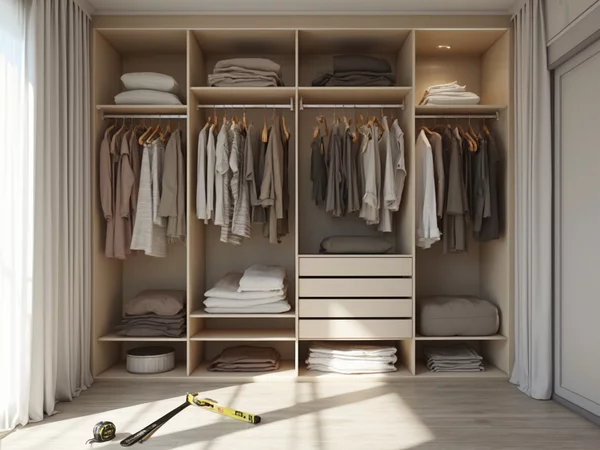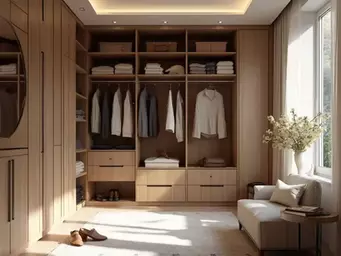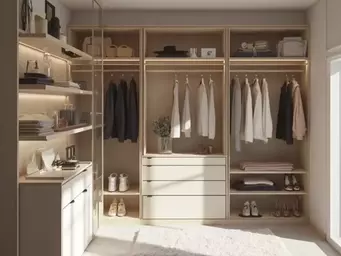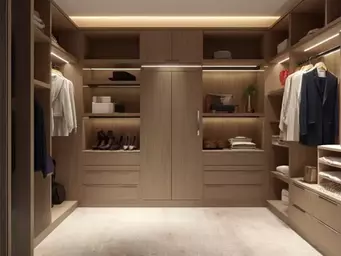Every walk-in robe project has its challenges, but you don’t have to face them alone. With the right insights and preparation, you can navigate the installation process smoothly and create a space that is both functional and stylish. Here’s what you’ll learn about overcoming common installation hurdles and making informed decisions for your DIY project.
What You Will Learn
- Common installation challenges include misalignment, structural stability, and design mistakes.
- Basic skills and tools are often sufficient for a successful DIY walk-in robe installation.
- Identifying potential problem areas before starting can significantly improve the installation process.
- Budgeting wisely by researching materials and looking for discounts can help you save money.
Common Challenges and Misconceptions in DIY Walk-In Robe Installation
This visual summarizes the key challenges DIYers face and common myths surrounding walk-in robe installations.
Installation Challenges
- ✖ Misalignment
- ✖ Structural stability
- ✖ Design mistakes
Common Misconceptions (Myths)
- ✓ Need advanced carpentry skills
- ✓ Specialized tools are a must
- ✓ DIY is always more complicated
Understanding Common Walk-In Robe Installation Problems
When embarking on a DIY walk-in robe project, many homeowners quickly encounter a variety of installation challenges. As someone who has guided countless clients through this process, I've seen firsthand how misalignment, structural stability, and design mistakes can arise. Understanding these challenges is crucial for a smooth installation experience!
Many DIYers often find themselves frustrated with the installation process, leading to potential delays or even costly mistakes. By identifying these common issues early on, you can avoid the pitfalls and create a beautifully organized space.
Identifying Installation Challenges for DIYers
So, what are the typical issues that can trip you up during your walk-in robe installation? Here are some of the most common challenges:
- Misalignment: Shelves and rods may not align properly, affecting both functionality and aesthetics.
- Structural stability: Units can become wobbly if not secured adequately to the wall. For instance, ensuring proper structural integrity is key for accessibility and safety, preventing issues like collapsing shelves.
- Design mistakes: Poor planning regarding spacing and layout can lead to a cramped or inefficient robe. Considering accessible design standards can help ensure your layout is functional for everyone.
By pinpointing these challenges, you can take proactive measures to minimize errors and enhance the functionality of your walk-in robe!
Common Misconceptions About Walk-In Robe Installation
There are a number of myths floating around about walk-in robe installations that can deter DIY enthusiasts. One prevalent misconception is that these projects require expert-level skills and tools. In reality, the necessary skills are often quite basic! Most homeowners can handle walk-in robe installations with the right guidance.
- Myth 1: You need advanced carpentry skills.
- Myth 2: Specialized tools are a must for successful installation.
- Myth 3: DIY installations are always more complicated than hiring professionals.
By debunking these myths, you can approach your walk-in robe project with confidence. In fact, with just a little preparation, you can create a stunning space that reflects your personal style!
Pro Tip
To ensure a seamless walk-in robe installation, always measure your space accurately before purchasing materials. A common mistake is to underestimate the dimensions of your area, leading to misalignment and wasted resources. Double-check your measurements and consider drawing a layout plan. This will not only help visualize your design but also guide you in purchasing the right amount of materials, saving time and money in the long run!
Frequently Asked Questions About Walk-In Robe Installation
Q: What are the most common challenges in DIY walk-in robe installation?
A: The most common challenges include misalignment of shelves and rods, ensuring structural stability of units, and making design mistakes that lead to a cramped or inefficient layout.
Q: Do I need advanced carpentry skills for a DIY walk-in robe?
A: No, a common misconception is that advanced carpentry skills are required. Most homeowners can successfully complete a walk-in robe installation with basic skills and the right guidance.
Q: How can I avoid misalignment during installation?
A: Accurate measurements are crucial. Double-check all dimensions before purchasing materials and consider drawing a detailed layout plan to visualize your design and prevent errors.
Q: What is the best way to ensure the structural stability of walk-in robe units?
A: Units must be adequately secured to the wall to prevent wobbling. Following installation instructions carefully and using appropriate anchors will ensure stability. For instance, understanding fair housing design guidelines can help ensure your structures are robust and safe.
Q: How can I budget effectively for my DIY walk-in robe project?
A: To budget wisely, research cost-effective materials, look for sales or discounts at home improvement stores, and consider repurposing items. Estimating costs for materials and tools upfront will help avoid overspending.
Wrapping Up Your Walk-In Robe Installation Journey
As we wrap up our exploration of walk-in robe installations, it’s essential to reflect on the common challenges and the practical solutions we've discussed. From misaligned shelves to uneven flooring, every issue can be resolved with proper preparation and a little bit of patience. Remember, troubleshooting is a part of the process! Taking the time to understand these issues can save you from much bigger headaches down the road.
I encourage you to keep these points in mind as you move forward with your project:
- Identify potential problem areas before you start.
- Use the right tools to troubleshoot effectively.
- Consider aesthetics along with functionality during design.
By keeping these key considerations in mind, you can achieve a walk-in robe that not only meets your storage needs but also enhances your overall living space.
Next Steps for a Successful DIY Project
Now that you are equipped with knowledge about common challenges and their solutions, it’s time for you to take action! Start applying the tips from this article to your walk-in robe project. Don’t hesitate to reach out to communities or forums dedicated to DIY home improvement for additional support and inspiration. Sharing your journey can also bring new ideas to light!
Consider documenting your progress on social media or a blog—your experiences could provide valuable insights for others embarking on similar projects. And remember, patience and persistence are your best friends throughout this process!
Exploring Budgeting for Your Walk-In Robe Installation
Budgeting is a crucial aspect of any DIY project, and your walk-in robe installation is no exception. By planning ahead, you can avoid overspending while still achieving a high-quality result. Start by estimating the costs of materials and tools you'll need. Here are some strategies to keep your budget in check:
- Research cost-effective materials that suit your design.
- Look for sales or discounts at local home improvement stores.
- Consider using pre-loved materials or repurposing items for a unique touch.
By taking these steps, you can create a beautiful and functional walk-in robe that reflects your personal style without breaking the bank. At The Walk In Robe Guide, we're here to help you navigate this journey, ensuring that you get the most value out of your investment.
Recap of Key Points
Here is a quick recap of the important points discussed in the article:
- Identify Installation Challenges: Recognize common issues such as misalignment, structural stability, and design mistakes to ensure a smoother installation process.
- Debunk Misconceptions: Many believe advanced skills or specialized tools are necessary for DIY installations; however, basic skills and common tools are often sufficient.
- Prioritize Planning: Take the time to plan your layout and design, considering both functionality and aesthetics to create an efficient and beautiful robe.
- Budgeting Wisely: Research cost-effective materials, look for discounts, and consider repurposing items to keep your project within budget.
- Stay Informed and Engaged: Participate in DIY communities for support and inspiration, and document your progress to share insights with others.




